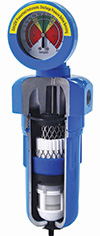
Pneumatic valves and cylinders are not cheap, so it makes good financial sense to protect them from premature failure. Water separators have no internal filter element, they rely on centrifugal motion. These will only collect liquids that have already condensed. They may be installed prior to a coalescing set to reduce the work load on the filter elements.

Generally the air standard for a mildly complex pneumatic system would be ISO 8573–1.4.1. All this will tell is that the particle content should be ≤ 0,10 micron, the water content should be to a dew point of 3°C and the oil content ≤0,01 mg/m³. For a coalescing filter to do this reliably and consistently is not difficult.
Coalescing filters use impact, Brownian motion and direct impact to provide this level of filtration. Solids are retained in the core of the filter, while liquid oils are deliberately allowed to permeate the outer anti re-entrainment sock to drip into the quiet zone of the filter bowl. It is normal for oils to saturate the bottom third of the filter element as this is the area where the oils coalesce from fine vapours into a concentrated liquid oil.
The hallmark of a good quality filter casing and element is that it is manufactured in high grade aluminium with a treated bowl to prevent corrosion. This has a reliable internal float drain or an external timed automatic drain and colour coded socks on the element for easy grade identification. The filter should ideally have a pleated filter media retained within an inner and outer stainless steel cage and the element life should be about one year.
A pleated filter media has at least 40% more surface area than a simple fibreglass tube or a filter that has the filter media wrapped around a central core. An added bonus would be a differential gauge that highlights when the element has reached the end of its useful life.
If you decide that oil-free air is required and that you want to use an activated carbon filter, at least two coalescing filters should precede the activated carbon filter. Activated carbon elements are designed to remove the last vapours of oil from the compressed air stream. If installed in isolation they will be overcome by the liquid oils and be saturated in days. An activated carbon filter normally will require change-out at three to four months. Unlike a coalescing filter, the oil is retained in the carbon and not released into the bowl area. To check
the status of an activated carbon filter, crack open the manual drain slowly and if liquid oils are ejected into your hand it’s time for an
element change. Activated carbon filters are not normally fitted with a differential pressure gauge.
Prices of good quality filters can vary considerably so check the primary cost and the secondary cost, often it’s the secondary element prices that will hurt your budget. Artic Driers has a very cost-effective range of coalescing and activated carbon filters at highly competitive rates.
For more information contact Allen Cockfield, Artic Driers International, +27 (0)11 420 0274, [email protected], www.articdriers.co.za
| Tel: | +27 11 420 0274 |
| Email: | [email protected] |
| www: | www.articdriers.co.za |
| Articles: | More information and articles about Artic Driers International |
© Technews Publishing (Pty) Ltd | All Rights Reserved